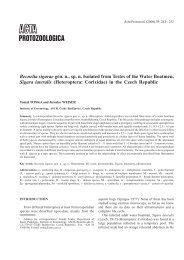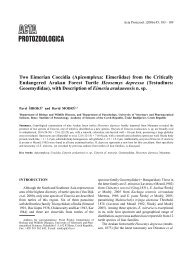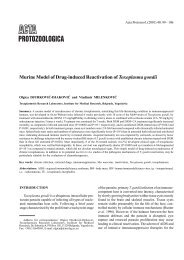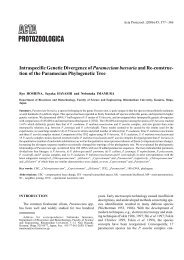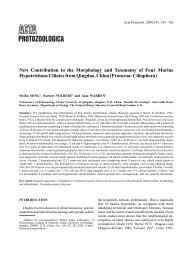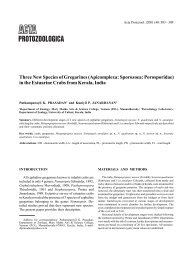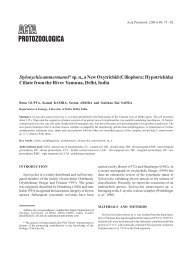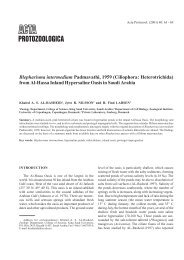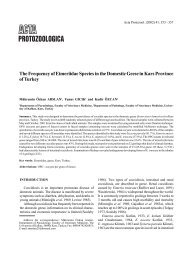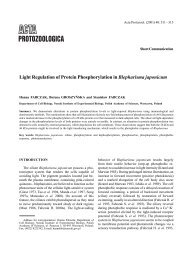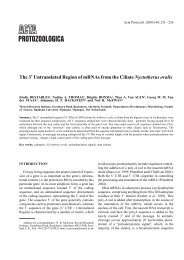Haemosporida of Birds of Prey and Owls from Germany
Haemosporida of Birds of Prey and Owls from Germany
Haemosporida of Birds of Prey and Owls from Germany
You also want an ePaper? Increase the reach of your titles
YUMPU automatically turns print PDFs into web optimized ePapers that Google loves.
286 O. Krone et al.<br />
Table 4. Prevalences <strong>of</strong> Leucocytozoon <strong>and</strong> Haemoproteus <strong>and</strong> number <strong>of</strong> birds examined in different regions <strong>of</strong> Europe (L - Leucocytozoon,<br />
H - Haemoproteus)<br />
Peirce <strong>and</strong> Mikaelian Peirce Sacchi <strong>and</strong> Svobodová Kuèera<br />
Marquiss <strong>and</strong> Bayol et al. (1983) Prigioni <strong>and</strong> Votýpka (1981a)<br />
(1983) (1991) (1984) (1998)<br />
Region Scotl<strong>and</strong> France Britain Spain Italy Czech Republic Europe<br />
(literature<br />
review)<br />
birds <strong>of</strong> prey 60% (6) 31% (14) 20.3% (17) 14.2% (12) 21.9% (15)<br />
(number <strong>of</strong> species) n = 235 n = 150 n = 54 n = 28 n = 114<br />
falconiform birds 60% (L,H) 35% (L,H) 2 (L,H) 3 (L,H) 22% (L,H) 24% (L) 2.5% (L)<br />
n = 229 n = 83 n = 33 n = 25 n = 91 n = 459 n = 334<br />
9.3% (H) 53.1% (H)<br />
n = 495 n = 178<br />
strigiform birds 3 (L,H) 30% (L,H) 9 (L,H) 1 (L,H) 22% (L,H) 9.9% (L)<br />
n = 6 n = 67 n = 21 n = 3 n = 23 n = 162<br />
22.6% (H)<br />
n = 178<br />
A. nisus 67% (L) 1 (H) 2 (L) 3 (L) 29% (L)<br />
16% (H) n = 4 1 (H) n = 7 12% (H)<br />
n = 195 n = 2 n = 308<br />
B. buteo 2 (L) 46% (L) 0 (L,H) 1 (L,H) 9 (L) 38% (L)<br />
n = 3 61% (H) n = 3 n = 9 n = 39 9% (H)<br />
n = 26 n = 99<br />
F. tinnunculus 0 (L,H) 20% (H) 0 (L,H) 0 (L,H) 1 (L) 0 (L)<br />
n = 6 n = 35 n = 12 n = 1 5 (H) 1.5% (H)<br />
n = 20 n = 66<br />
F. peregrinus 0 (L,H) 0 (L,H) 0 (L,H)<br />
n = 25 n = 3 n = 2<br />
F. subbuteo 2 (H)<br />
n = 4<br />
S. aluco 3 (L) 14% (L) 6 (L) 2 (L)<br />
0 (H) 50% (H) 2 (H) 1 (H)<br />
n = 4 n = 22 n = 12 n = 7<br />
A. otus 0 (L,H) 45% (H) 1 0 (L,H) 0 (L,H)<br />
n = 2 8% (L) n = 1 n = 6<br />
n = 11<br />
T. alba 0 (L,H) 0 (L,H) 0 (L,H) 0 (L,H)<br />
n = 17 n = 1 n = 2 n = 5<br />
cantly higher prevalence for L. toddi than for<br />
H. elani (P



